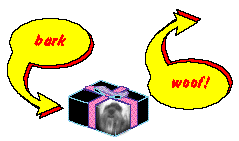|
|

a = 1;
b = 2;
c = a + b;
This says,
"Take a, which has the value 1, and b, which has the value 2, and add them together using the C language's built-in addition capability. Take the result, 3, and place it into the variable called c."
Now, here's the same thing expressed in Smalltalk, which is a pure object-oriented language:
a := 1.
b := 2.
c := a + b.
Wait a minute. Except for some minor notational differences, this looks exactly the same! Okay, it is the same, but the meaning is dramatically different.
In Smalltalk, this says,
"Take the object a, which has the value 1, and send it the message "+", which included the argument b, which, in turn, has the value 2. Object a, receive this message and perform the action requested, which is to add the value of the argument to yourself. Create a new object, give this the result, 3, and assign this object to c."
Hmm. This seems like a far more complicated way of accomplishing exactly the same thing! So why bother?
The reason is that objects greatly simplify matters when the data get more complex. Suppose you wanted a data type called list, which is a list of names. In C, list would be defined as a structure.
struct list {
<definition
of list structure data here>
};
list a, b,
c;
a = "John Jones";
b = "Suzy Smith";Let's try to add these new a and b in the C language:
c = a + b;
Guess what? This doesn't work. The C compiler will generate an error when it tries to compile this because it doesn't know what to do with a and b. C compilers just know how to add numbers. Period. But a and b are not numbers. One can do the same thing in Smalltalk, but this time, list is made a class, which is a subclass of the built-in Smalltalk class called "String":
a := List fromString: 'John Jones'.
b := List fromString: 'Suzy
Smith'.
c := a + b.
The first two lines simply create List objects a and b from the given strings. This now works, because the list class was created with a method which specifically "knows" how to handle the message "+". For example, it might simply combine the argument with its own object by sticking them together with a comma separating them (this is done with a single line of Smalltalk). So c will have the new value:
'John Jones, Suzy Smith'
Here's another example of a "+" message using more interesting objects. Click a, b, and c in turn to find out what they are (you'll need a WWW browser with support for "aiff" sounds):
Using Non-Object-Oriented Languages
I
t's also possible to use objects and messages in plain old non-object-oriented languages. This is done via function calls, which look ordinary, but which have object-oriented machinery behind them. Among other things, this allows sophisticated client-server software to run "transparently" from within ordinary programming languages.Suppose you added a "plus" function to a C program:
int plus(int arg1, int arg2)
{return (arg1 + arg2); }
This hasn't really bought you anything yet. But suppose that instead of doing the addition on your own computer, you automatically sent it to a server computer to be performed:
int plus(int arg1, int arg2)
{ return server_plus(arg1, arg2);
}
The function server_plus() in turn creates a message containing arg1 and arg2, and sends this message, via a network, to a special object which sits on a server computer. This object executes the "plus" function and sends the result back to you. It's object-oriented computing via a back-door approach!
This example is not very fancy, and, of course, it's easier to simply add two numbers directly. But as the musical example illustrated, there's no limit to the complexity of an object. A single object can include entire databases, with millions of pieces of information. In fact, such database objects are common in client-server software.
This also illustrates the flexibility of the object-oriented approach. In the usage just described, the object is very different from the earlier "a + b" example. Here, it receives two arguments, namely, the two objects that it is supposed to add. Previously, in the Smalltalk example, the object that was receiving a message was the first object, a. But in a client-server environment, the addition is not done locally, on the client machine, but remotely, on a server machine. The server machine contains the object that the message is sent to, and since it doesn't know anything about the first argument, you have to send both arguments.
Inheritance
I
f there is already a class which can respond to a bunch of different messages, what if you wanted to make a new, similar class which adds just a couple of more messages? Why have to re-write the entire class?Of course, in any good object-oriented language, you don't. All you need to do is create a subclass (or derived class, in C++ terminology) of the original class. This new class inherits all the existing messages, and therefore, all the behavior of the original class. The original class is called the parent class, or superclass, of the new class. Some more jargon -- a subclass is said to be a specialization of its superclass, and the conversely a superclass a generalization of its subclasses.
Inheritance also promotes reuse. You don't have to start from scratch when you write a new program. You can simply reuse an existing repertoire of classes that have behaviors similar to what you need in the new program.
For example, after creating the class Dog, you might make a subclass called Wolf, which defines some wolf-specific messages, such as hunt. Or it might make more sense to define a common class called Canis, of which both Dog and Wolf are subclasses.
Much of the art of o-o programming is determining the best way to divide a program into an economical set of classes. In addition to speeding development time, proper class construction and reuse results in far fewer lines of code, which translates to less bugs and lower maintenance costs.
Object-Oriented Languages
T
here are almost two dozen major object-oriented programming languages in use today. But the leading commercial o-o languages are far fewer in number. These are:- C++
- Smalltalk
- Java
C++
C++ is an object-oriented version of C. It is compatible with C (it is actually a superset), so that existing C code can be incorporated into C++ programs. C++ programs are fast and efficient, qualities which helped make C an extremely popular programming language. It sacrifices some flexibility in order to remain efficient, however. C++ uses compile-time binding, which means that the programmer must specify the specific class of an object, or at the very least, the most general class that an object can belong to. This makes for high run-time efficiency and small code size, but it trades off some of the power to reuse classes.
C++ has become so popular that most new C compilers are actually C/C++ compilers. However, to take full advantage of object-oriented programming, one must program (and think!) in C++, not C. This can often be a major problem for experienced C programmers. Many programmers think they are coding in C++, but instead are only using a small part of the language's object-oriented power.
Smalltalk
Smalltalk is a pure object-oriented language. While C++ makes some practical compromises to ensure fast execution and small code size, Smalltalk makes none. It uses run-time binding, which means that nothing about the type of an object need be known before a Smalltalk program is run.Smalltalk programs are considered by most to be significantly faster to develop than C++ programs. A rich class library that can be easily reused via inheritance is one reason for this. Another reason is Smalltalk's dynamic development environment. It is not explicitly compiled, like C++. This makes the development process more fluid, so that "what if" scenarios can be easily tried out, and classes definitions easily refined. But being purely object-oriented, programmers cannot simply put their toes in the o-o waters, as with C++. For this reason, Smalltalk generally takes longer to master than C++. But most of this time is actually spent learning object-oriented methodology and techniques, rather than details of a particular programming language. In fact, Smalltalk is syntactically very simple, much more so than either C or C++.
Unlike C++, which has become standardized, The Smalltalk language differs somewhat from one implementation to another. The most popular commercial "dialects" of Smalltalk are:
- VisualWorks from ParcPlace-Digitalk, Inc.
- Smalltalk/V and Visual Smalltalk from ParcPlace-Digitalk Inc.
- VisualAge from IBM
VisualWorks
VisualWorks is arguably the most powerful of Smalltalks. VisualWorks was developed by ParcPlace, which grew out of the original Xerox PARC project that invented the Smalltalk language. VisualWorks is platform-independent, so that an application written under one operating system, say, Microsoft Windows, can work without any modification on any of a wide range of platform supported by ParcPlace, from Sun Solaris to Macintosh. VisualWorks also features a GUI (Graphic User Interface) builder that is well-integrated into the product.
Smalltalk/V and Visual Smalltalk
Digitalk's versions of Smalltalk are somewhat smaller and simpler, and are specifically tailored to IBM compatible PCs. A Macintosh version was available, but support has since been abandoned. This does not bode well for Digitalk cross-platform efforts. Digitalk has a separate GUI builder, called PARTS Workbench (bundled with Visual Smalltalk), which allows quick construct of an application.
ParcPlace and Digitalk were merged into a single company, ParcPlace-Digitalk, Inc. The future of the Digitalk product line is uncertain, and it may just be spun off back into a separate company.
VisualAge
IBM's version of Smalltalk, VisualAge, is comparable to Smalltalk/V with PARTS. Both of these Smalltalks allow programmers to readily exploit machine-specific features, at the expense of some portability. IBM has adapted existing industry standards for such things as file management and screen graphics. When IBM talks, people listen, and IBM has made a substantial commitment to Smalltalk.
Java
Java is the latest, flashiest object-oriented language. It has taken the software world by storm due to its close ties with the Internet and Web browsers. It is designed as a portable language that can run on any web-enabled computer via that computer's Web browser. As such, it offers great promise as the standard Internet and Intranet programming language.
Java is a curious mixture of C++ and Smalltalk. It has the syntax of C++, making it easy (or difficult) to learn, depending on your experience. But it has improved on C++ in some important areas. For one thing, it has no pointers, low-level programming constructs that make for error-prone programs. Like Smalltalk, it has garbage collection, a feature that frees the programmer from explicitly allocating and de-allocating memory. And it runs on a Smalltalk-style virtual machine, software built into your web browser which executes the same standard compiled Java bytecodes no matter what type of computer you have.
Java development tools are being rapidly deployed, and are available from such major software companies as IBM, Microsoft, and Symantec.
In Summary
O
bject-oriented programming offers a new and powerful model for writing computer software. Objects are "black boxes" which send and receive messages. This approach speeds the development of new programs, and, if properly used, improves the maintenance, reusability, and modifiability of software.O-o programming requires a major shift in thinking by programmers, however. The C++ language offers an easier transition via C, but it still requires an o-o design approach in order to make proper use of this technology. Smalltalk offers a pure o-o environment, with more rapid development time and greater flexibility and power. Java promises much for Web-enabling o-o programs.

